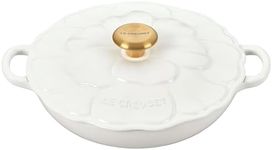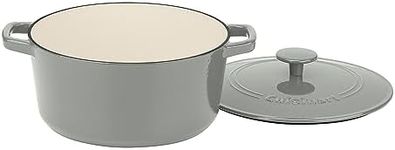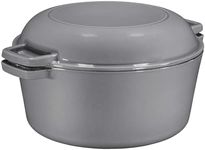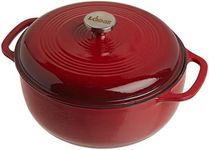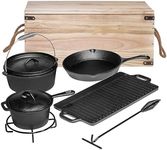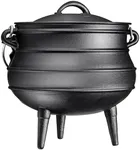Buying Guide for the Best Cast Iron Braisers
Choosing the right cast-iron braiser can significantly enhance your cooking experience. A braiser is a versatile piece of cookware that can be used for searing, browning, and slow-cooking a variety of dishes. When selecting a cast-iron braiser, it's important to consider several key specifications to ensure it meets your cooking needs and preferences. Understanding these specifications will help you make an informed decision and find the best fit for your kitchen.Size/CapacityThe size or capacity of a cast-iron braiser is crucial because it determines how much food you can cook at once. Braisers typically range from 2 to 7 quarts. Smaller braisers (2-3 quarts) are ideal for cooking for one or two people or for making side dishes. Medium-sized braisers (4-5 quarts) are versatile and suitable for small families or for cooking main dishes. Larger braisers (6-7 quarts) are perfect for big families or for entertaining guests. Consider your typical cooking needs and the number of people you usually cook for when choosing the size.
ShapeCast-iron braisers come in different shapes, primarily round and oval. The shape can affect how the heat is distributed and how the food fits in the braiser. Round braisers are great for even heat distribution and are generally more versatile for a variety of dishes. Oval braisers are better suited for cooking larger cuts of meat or whole poultry. Think about the types of dishes you plan to cook most often to determine which shape will be more practical for you.
WeightThe weight of a cast-iron braiser is important because it affects how easy it is to handle. Cast iron is naturally heavy, but some braisers are heavier than others. Heavier braisers tend to retain heat better and provide more even cooking, but they can be difficult to lift and maneuver, especially when full. Lighter braisers are easier to handle but may not retain heat as well. Consider your own strength and comfort level with handling heavy cookware when choosing the weight of your braiser.
LidThe lid of a cast-iron braiser plays a significant role in the cooking process. A tight-fitting lid helps to retain moisture and heat, which is essential for braising. Some lids are designed with self-basting spikes on the underside to help keep the food moist. Others may be flat or domed. A glass lid allows you to monitor the cooking process without lifting the lid, but it may not retain heat as well as a cast-iron lid. Consider how important moisture retention and visibility are to you when selecting a braiser with the right lid.
Enamel CoatingMany cast-iron braisers come with an enamel coating, which provides a non-reactive and easy-to-clean surface. Enamel-coated braisers do not require seasoning and are less prone to rust. They are available in a variety of colors, adding aesthetic appeal to your kitchen. However, enamel can chip if not handled carefully. If you prefer low-maintenance cookware and like the idea of adding a pop of color to your kitchen, an enamel-coated braiser might be the right choice for you. If you prefer traditional cast iron and don't mind the extra care, a non-coated braiser could be a better fit.
HandlesThe handles on a cast-iron braiser are important for safe and easy handling. Look for braisers with large, sturdy handles that provide a secure grip, even when wearing oven mitts. Some braisers have loop handles, while others have more elongated handles. Consider how comfortable the handles feel in your hands and how easy it is to lift and carry the braiser, especially when it's full of food. Good handles can make a big difference in the overall usability of the braiser.


